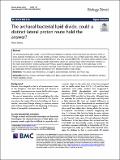Por favor, use este identificador para citar o enlazar a este item:
http://hdl.handle.net/10261/209067COMPARTIR / EXPORTAR:
 SHARE SHARE
 CORE
BASE CORE
BASE
|
|
| Visualizar otros formatos: MARC | Dublin Core | RDF | ORE | MODS | METS | DIDL | DATACITE | |

| Campo DC | Valor | Lengua/Idioma |
|---|---|---|
| dc.contributor.author | Mencía, Mario | - |
| dc.date.accessioned | 2020-04-26T06:31:07Z | - |
| dc.date.available | 2020-04-26T06:31:07Z | - |
| dc.date.issued | 2020 | - |
| dc.identifier.citation | Biology Direct 15(1): 7 (2020) | - |
| dc.identifier.uri | http://hdl.handle.net/10261/209067 | - |
| dc.description.abstract | The archaea-bacteria lipid divide is one of the big evolutionary enigmas concerning these two domains of life. In short, bacterial membranes are made of fatty-acid esters whereas archaeal ones contain isoprenoid ethers, though at present we do not have a good understanding on why they evolved differently. The lateral proton transfer mode of energy transduction in membranes posits that protons utilize the solvation layer of the membrane interface as the main route between proton pumps and ATPases, avoiding dissipation of energy to the bulk phase. In this article I present the hypothesis on a proton-transport route through the ester groups of bacterial phospholipids as an explanation for the evolutionary divergence seen between bacteria and archaea. | - |
| dc.description.sponsorship | This work was supported by grant BIO2016-77031R from the Spanish Ministry of Science, Innovation and Universities (MICIU). | - |
| dc.language.iso | eng | - |
| dc.publisher | BioMed Central | - |
| dc.relation | info:eu-repo/grantAgreement/MINECO/Plan Estatal de Investigación Científica y Técnica y de Innovación 2013-2016/BIO2016-77031-R | - |
| dc.relation.isversionof | Publisher's version | - |
| dc.rights | openAccess | - |
| dc.subject | Bacteria | - |
| dc.subject | Archaea | - |
| dc.subject | Membrane lipids | - |
| dc.subject | Ester lipids | - |
| dc.subject | Lateral proton transfer | - |
| dc.subject | Energetics | - |
| dc.subject | Membrane interface | - |
| dc.subject | Proton gradient | - |
| dc.subject | ATPase | - |
| dc.title | The archaeal-bacterial lipid divide, could a distinct lateral proton route hold the answer? | - |
| dc.type | artículo | - |
| dc.identifier.doi | 10.1186/s13062-020-00262-7 | - |
| dc.description.peerreviewed | Peer reviewed | - |
| dc.relation.publisherversion | https://doi.org/10.1186/s13062-020-00262-7 | - |
| dc.identifier.e-issn | 1745-6150 | - |
| dc.date.updated | 2020-04-26T06:31:08Z | - |
| dc.rights.license | http://creativecommons.org/licenses/by/4.0/ | - |
| dc.contributor.funder | Ministerio de Economía y Competitividad (España) | - |
| dc.relation.csic | Sí | - |
| dc.identifier.funder | http://dx.doi.org/10.13039/501100003329 | es_ES |
| dc.identifier.pmid | 32317017 | - |
| dc.type.coar | http://purl.org/coar/resource_type/c_6501 | es_ES |
| item.grantfulltext | open | - |
| item.openairetype | artículo | - |
| item.cerifentitytype | Publications | - |
| item.languageiso639-1 | en | - |
| item.fulltext | With Fulltext | - |
| item.openairecristype | http://purl.org/coar/resource_type/c_18cf | - |
| Aparece en las colecciones: | (CBM) Artículos | |
Ficheros en este ítem:
| Fichero | Descripción | Tamaño | Formato | |
|---|---|---|---|---|
| Archaeal_Mencia_Art2020.pdf | 1,03 MB | Adobe PDF |  Visualizar/Abrir |
CORE Recommender
PubMed Central
Citations
3
checked on 30-abr-2024
SCOPUSTM
Citations
7
checked on 10-may-2024
WEB OF SCIENCETM
Citations
7
checked on 23-feb-2024
Page view(s)
135
checked on 13-may-2024
Download(s)
111
checked on 13-may-2024

